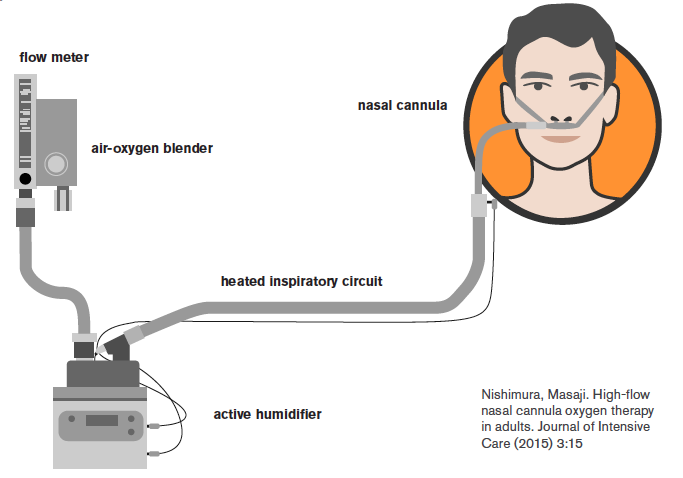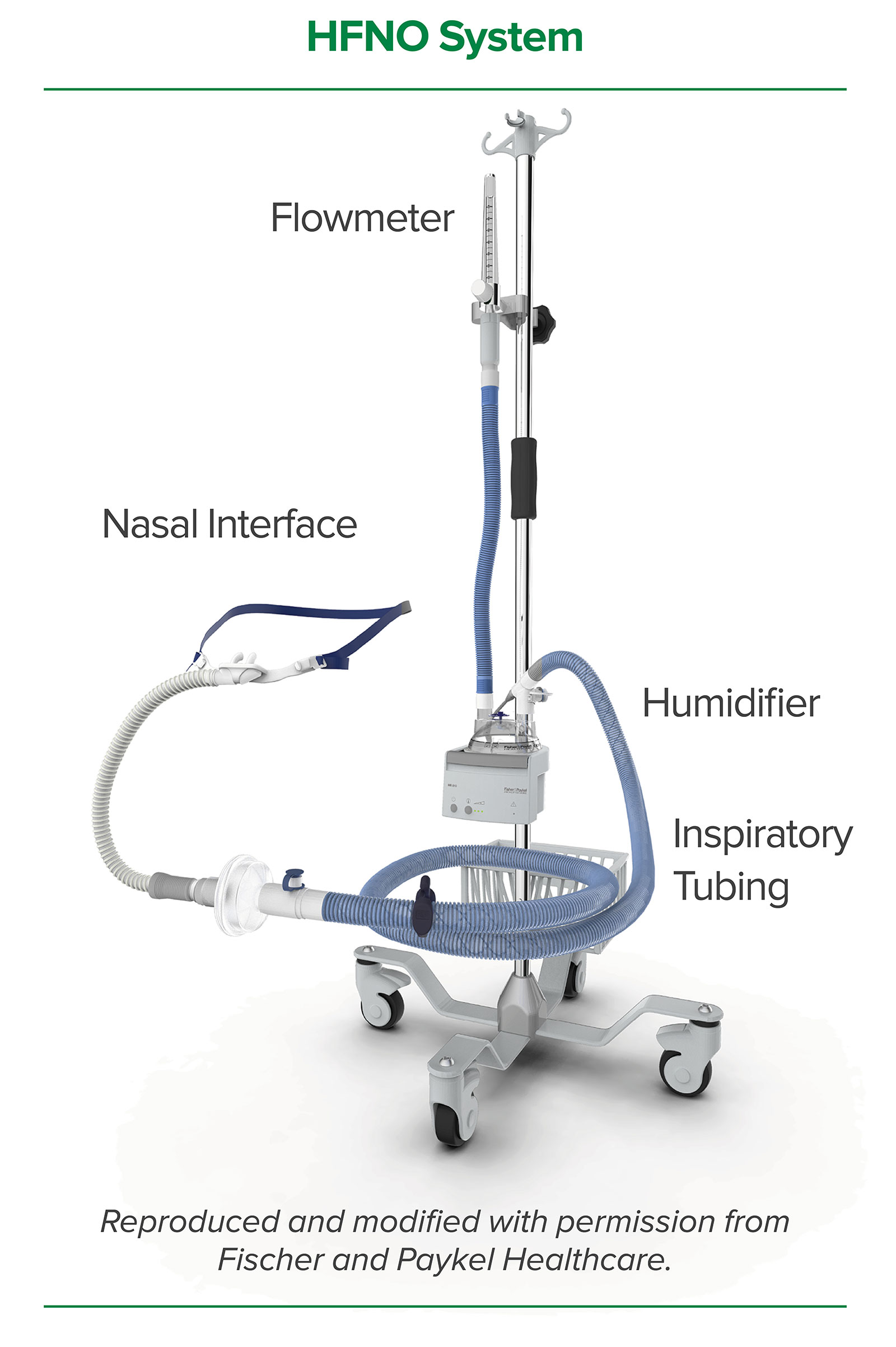heated high flow oxygen settings
High-flow nasal cannula aka heated humidified HFNC or high floe nasal prongs used in cases of hypoxic respiratory failure. FiO2 titrate to SpO2 goal With increasing flow rate may be able to decrease FiO2 High-Flow Oxygen Nasal Cannula HFNC.

High Flow Oxygen Cuts Ventilator Use Speeds Covid Recovery Cidrap
Note that any discomfort is usually due to the velocity of gas rather than the flow itself and may be eased by using a large-bore cannula.

. He deteriorated suddenly 5 days later. The gas is heated and humidified with the active humidifier and delivered through the heated circuit Figure 1. Background Although commonly used inside hospitals no previous case report has been published on high-flow nasal oxygen HFNO therapy in an adult in the prehospital settingCase Report A 46-year-old nonsmoking man presented with a cough and fever.
Intubation pre-oxygenation and apnoeic oxygenation. Up to 100 humidified oxygen can be delivered at a high flow rate up to 60 Lmin that meets inspiration. Published clinical protocols may give guidance to setting flow rates in children.
High-Flow Oxygen Nasal Cannula HFNC Settings -Flow Rate 5 to 60 liters per minute - FiO2 021 to 10 - Initial Set Up Flow -may want to start at 20-35 liters per minute and titrate to to patients work of breathing WOB. Introduction Adequate oxygenation is a priority in all acutely ill emergency department ED patients. These high-flow nasal cannula HFNC systems enhance patient comfort and tolerance compared with traditional high-flow oxygenation systems such as nasal masks and nonrebreathing systems.
Oxygen is heated and humidified and then delivered to the patient usually through nasal cannulae in nasal high flow NHF therapy. If oxygen exceeds 95 the oxygen reading will pulse red and the device will alarm. The flow rate and fi02 can be independently titrated based.
Note that any discomfort is usually due to the velocity of gas rather than the flow itself and may be eased by using a large-bore cannula. In order to optimize the humidification effect the temperature should be set at 37C. In recent years nasal cannulae designed to administer heated and humidified airoxygen mixtures at high flows up to 60 Lmin have been gaining popularity.
High-flow nasal cannula HFNC therapy is an oxygen supply system capable of delivering up to 100 humidified and heated oxygen at a flow rate of up to 60 liters per minute. By delivering up to 100 oxygen at a maximum flow rate of 60Lmin HFNO minimizes the entrainment of room air and subsequently increases the FiO 2. The maximum flow rate is 60 mLminute.
In order to optimize the humidification effect the temperature should be set at 37C. It delivers high inspiratory gas flow up to 60 litres per minute which is warmed and humidified. HFNT has become increasingly used for management of patients with type 1 respiratory failure.
7-12 The graphic below summarizes the findings from published literature. This includes a high-flow nasal cannula a high-flow source with systems regulating the flow and the FiO 2 a humidifier system and heated tubing. All settings are controlled independently allowing for greater confidence in the delivery of supplemental oxygen as well as better outcomes when used.
It actually takes gas and can heat it to 37 o C with a 100 relative humidity and can deliver 021 100 fi02 at flow rates of up to 60 litersmin. You can increase it in increments of 10 lmin up to 60 lmin and monitor the patients clinical condition. High-flow oxygen administration by nasal cannula for adult and perinatal patients.
High-flow oxygen therapy can be used as a step between conventional oxygen therapy non-invasive ventilation or mechanical ventilation allowing the patient to receive level 2 care on the ward setting and possibly prevent admission to the intensive therapy unit ITU. Warming and humidification of secretions Warming inspired oxygen and heating it to core temperature is more effective at high flow. High-flow nasal cannula refers to heated and humidified oxygen delivered through a wide bore nasal cannula at flow rates of up to 60 liters per minute LPM.
Abdominal distention and barotrauma can occur from high flow settings. When the basic life support team arrived his peripheral. Another major difference between NIV and HFNC is the interface.
At the airoxygen blender the inspiratory fraction of oxygen F I O 2 is set from 021 to 10 in a flow of up to 60 Lmin. Subsequently entrained room air dilutes the oxygen which in turn decreases the FiO 2. The flow rates make HFNC a form of non-invasive ventilation NIV.
You can increase it in increments of 10 lmin up to 60 lmin and monitor the patients clinical condition. No separate temperature probes or adapters are required. 5 This system provides high-flow 30 to 60 LPM oxygen that is heated to body temperature 37 o C and is fully saturated 100 relative humidity with minimal or no rainout in the tubing.
This flow commonly exceeds the maximum 15Lmin flow rate that usual devices deliver. Initial settings include a flow rate of 30 mLminute which can be raised as tolerated by the patient. Need for high FiO2 oxygen delivery in settings such as.
When compared with the 900PT501 Airvo tube in internal Fisher Paykel Healthcare testing. The AirSpiral heated breathing tube with integrated dual-spiral heated wires and temperature sensor. Oxygen can be titrated 21-95.
Humidified Gas at high flow rates Flow rates from 30-60 L UIHC policy for adults start at 50Lm Adjustable FiO2 from 21-100 Large Bore Nasal Cannula or Trach Connection. 7-12Published clinical protocols may give guidance in setting flows for infants between 10-125kg purple. Heated humidified high-flow HHHF therapy often also high flow nasal cannula e HFNC or high flow nasal oxygen HFNO is a type of respiratory support method that delivers a high flow liters per minute of medical gas to a patient through an interface nasal cannulae intended to create a wash-out of the upper airway.
Heat and humidified high flow nasal cannula or as most call it Hi Flow Nasal Cannula HFNC isnt just a standard nasal cannula cranked up to very high flow rates. FiO 2 can be set up to 100. 47-12There is sufficient clinical evidence that supports flow rates of 2 Lkgmin.

How Does High Flow Nasal Cannula Hfnc Work Medmastery

How Does High Flow Nasal Cannula Hfnc Work Medmastery

How Does High Flow Nasal Cannula Hfnc Work Medmastery

Youtube Respiratory Therapy Student Respiratory Care Respiratory Therapy

Introduction To The High Flow Nasal Cannula Ems Airway

A Better Way To Treat Hypoxia Emergency Physicians Monthly

What Is High Flow Nasal Cannula Hfnc Medmastery

An Introduction To The F P Airvo 2 For Optiflow Nasal High Flow Therapy Youtube

What Is A High Flow Nasal Cannula Hfnc Flow Oxygen Medical Equipment
The High Flow Nasal Cannula In The Emergency Department Emupdates

Setting Up The Airvo 2 High Flow Nasal Cannula Gaming Products Flow Electronic Products

Schematic Representation Of A High Flow Oxygen Device And Its Download Scientific Diagram

40 Vs 60 L Min What S The Difference Between Vapotherm High Velocity Therapy And High Flow Nasal Cannula Vapotherm

Equipment Used For The Nasal High Flow Oxygen Therapy System We Used A Download Scientific Diagram

High Flow Nasal Cannula Oxygen Therapy Devices Respiratory Care

What Is High Flow Nasal Cannula Hfnc Medmastery

Safe Use Of High Flow Nasal Oxygen Hfno With Special Reference To Difficult Airway Management And Fire Risk Anesthesia Patient Safety Foundation

High Flow Nasal Cannula Oxygen Therapy Devices Respiratory Care

Pin By Nacho Redondo Garcia On Anestesia Acute Respiratory Failure Oxygen Flow